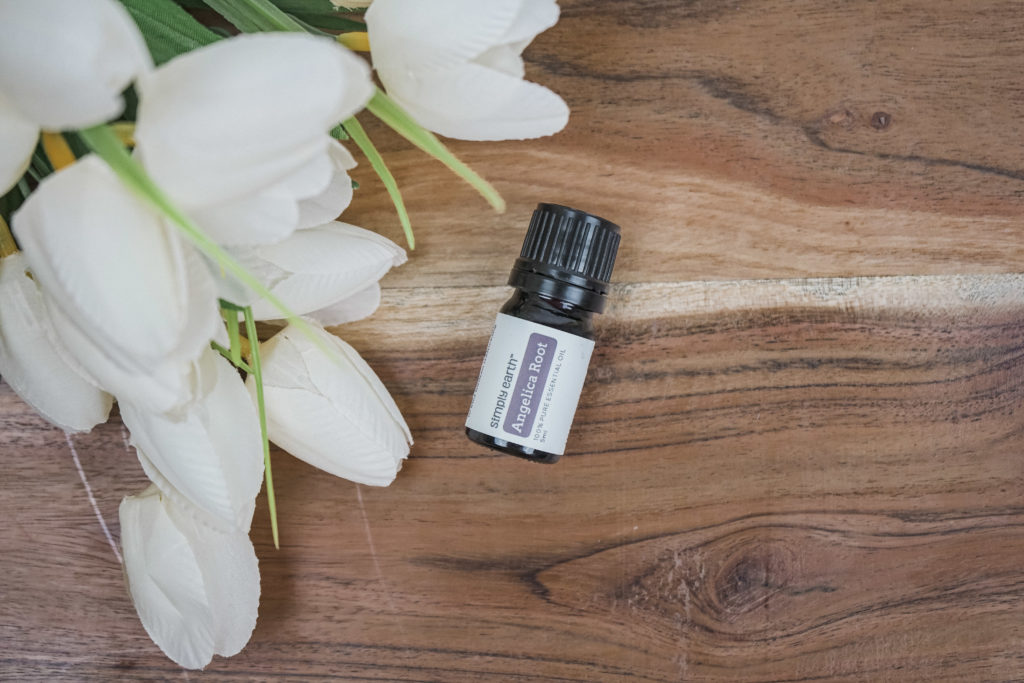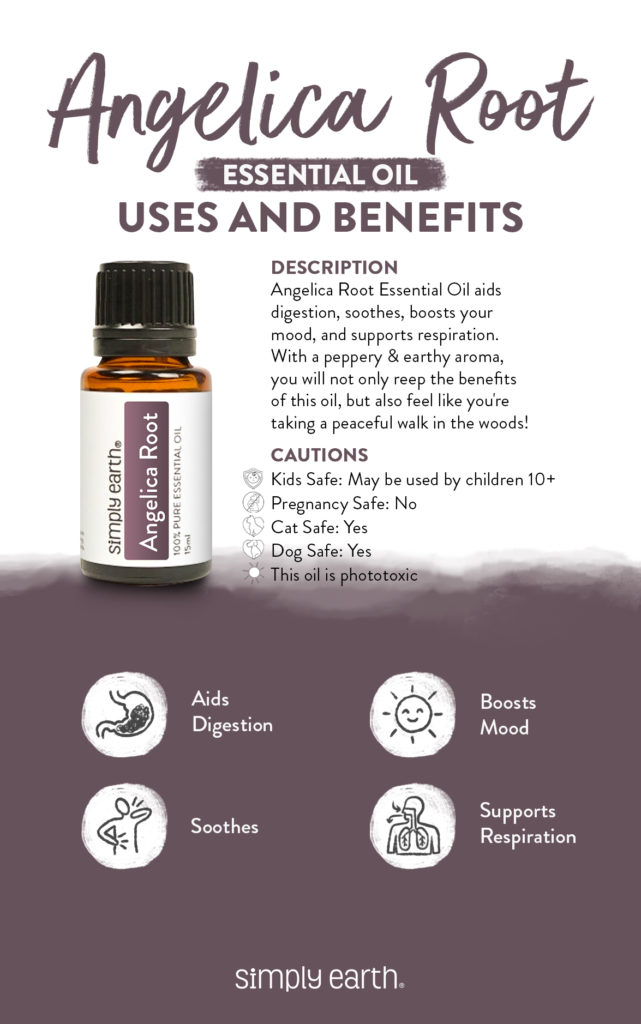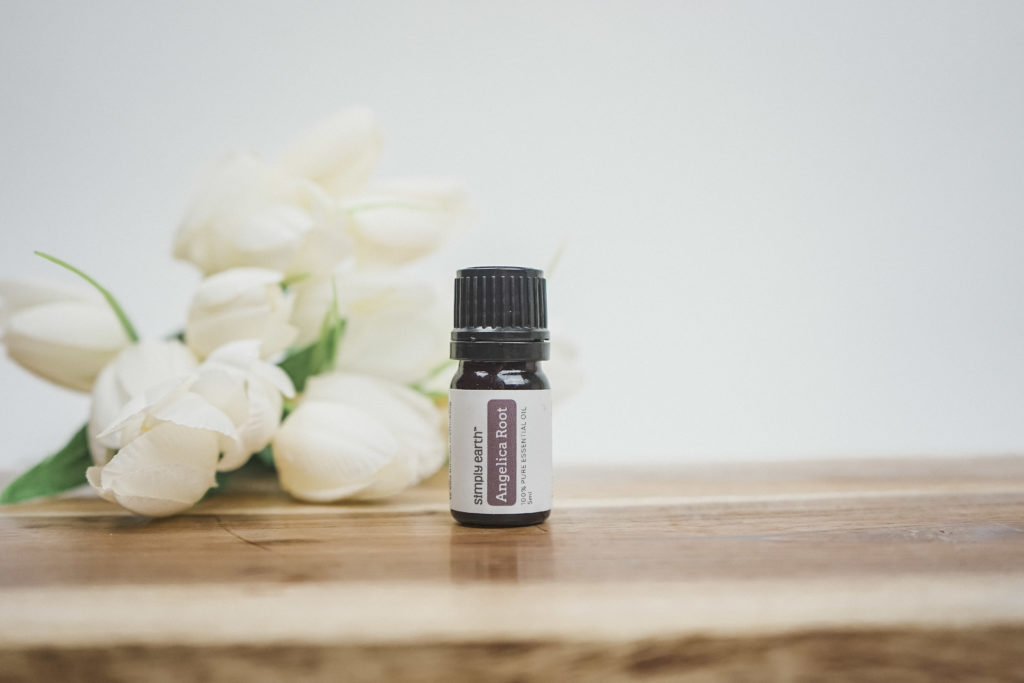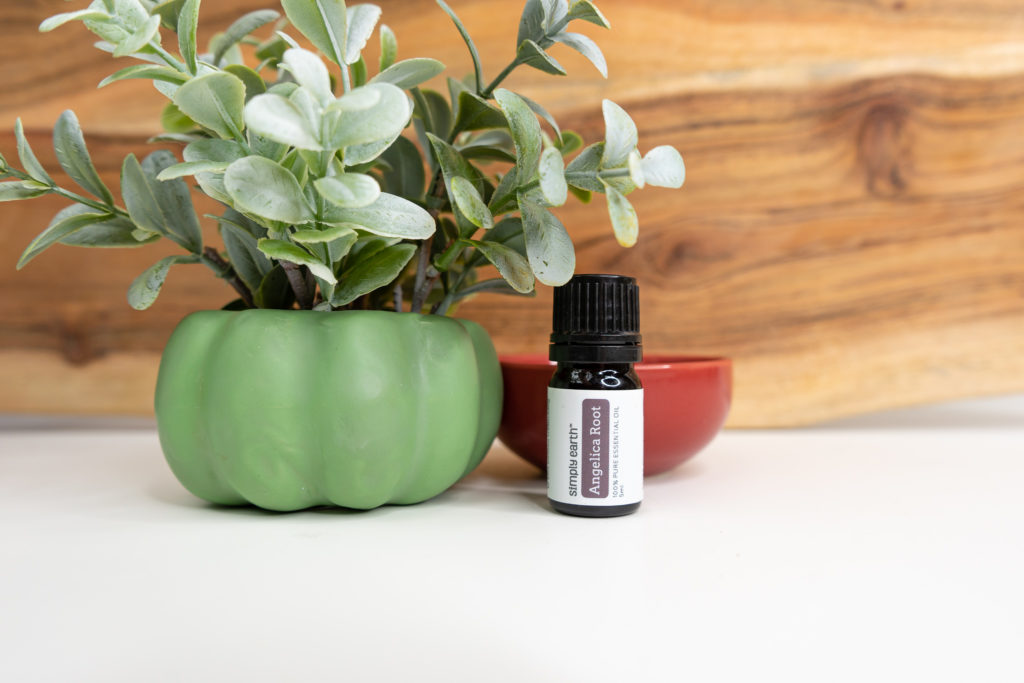We’d like to go deeper with you into Angelica Root Essential Oil uses and benefits. This oil has an arsenal of healing properties! The root of the angelica tree is the major source of essential oil through steam distillation. The oil color ranges from clear to a light brownish yellow. The seeds usually are the source of clear essential oil, but we will be focusing on the root oil in this blog post.
The green, earthy aroma of Angelica Root Oil reminds us of the quiet green forests where you can go to get away from stress, anxiety, depression or fear. It enables you to release negative thoughts and feelings with just a drop.
Recipes, Uses, and Benefits of Angelica Root

Soothes Stress and Anxiety
Inhaling Angelica Root Essential Oil can reduce temporary feelings of stress and anxiety because of the oil’s uplifting qualities1. The same effect is achieved when the body is massaged with this oil.
Soothes
According to a study, Angelica Root Oil may have strong anti-inflammatory properties2 which could be used to help soothe headaches, fevers, and flu symptoms. Angelica Root Essential Oil may also be helpful for women suffering from uncomfortable menopausal symptoms and other female hormonal issues as one study suggests3.
Relaxes
With the oil’s ability to soothe anxiety also comes its capability to induce relaxation. We love adding Angelica Root Oil in personal care recipes to boost its relaxing effects.
Promotes Skin Healing
Angelica Root can help support your body’s natural healing. Dilute it an apply it to an affected area to give your body a boost towards health.

What to Blend With Angelica Root Essential Oil
Angelica Root Essential Oil has a peppery and earthy aroma that blends well with Cedarwood, Lavender, Lemon, Tea tree, Mandarin, Patchouli, and Vetiver Essential Oils.
History and Background of Angelica Root

History
The Angelica plant has been long cultivated as ornamental and as a vegetable before the use of angelica root essential oil became popular in Scandinavia in the 12th century for its medicinal benefits and healing abilities. By then, Angelica was already growing wild in Sweden, Denmark, France, and Russia. During the 1660 plagues, the usefulness of Angelica spread to Europe and China, where the aromatic stems were chewed to stop infection and made as a health tonic. The roots and seeds were also burned to purify the air.
The herbal and therapeutic properties of angelica root created a very striking history. Eventually, applications became broader as it was used in America and other parts of the world as blending oil in aromatherapy. Angelica root was also proven effective in improving blood circulation, purifying the lymph system and reducing uric acid. The most prominent Angelica Root Essential Oil producing countries today are the UK, China, Germany, Belgium, Hungary, and India.
Background
The angelica plant belongs to the Apiaceae family. It is a small tree that grows from 1 to 3 meters tall. This plant appears very ornamental with wide, pinned hairy leaves and clusters of white to greenish-white or yellow-green umbrella-like flowers. The entire angelica plant is very aromatic or sweetly scented. It is a biennial plant that only grows its leaves in the first year, with hollow stems that can reach a height of up to 6 feet in the second year.
What Earthies Are Saying About This Oil
What I Love About This Oil

There are so many positive things to say about this oil! Not only does it smell amazing with its peppery and earthy aroma, but it also has outstanding benefits in physical and mental health.
Things to Remember When Using Angelica Root Essential Oil

Always dilute an essential oil when using it on the skin. This essential oil recipe is unlikely to cause skin irritation when diluted properly. If the oil has oxidized (been left with the cap off for long periods of time), it is more likely to cause skin irritation. Check out this dilution chart for diluting this essential oil properly.

This oil is generally not safe to use if you are pregnant. Consult your doctor prior to use.

This essential oil is safe to use with kids 10+.

This essential oil is generally safe to diffuse and use topically on cats. For more information on using essential oils with cats, check out this blog post.

For more information on using essential oils with dogs, check out this blog post.
We don’t recommend ingesting essential oils unless under the direction of a doctor certified in aromatherapy. For more information on why we don’t ingest essential oils check out this blog post.
*Please note: This post is a compilation of suggestions made by those that have extensively used essential oils and has not been verified scientifically with clinical tests nor reviewed by medical experts. It is anecdotal information and should be treated as such. For serious medical concerns, please consult your doctor. The statements given in this blog post have not been verified by the FDA
What Will You Blend With This Oil?

There are so many benefits of Angelica Root Essential Oil! What will you create first with this oil in your pocket? We’d love to hear about it on social media with @fromsimplyearth and in the comments below!
To learn more about how to use essential oils, check out our Simply Earth Essential Oil Recipe Box. When you subscribe, we’ll ship you a monthly supply of four 100% pure essential oils, six natural recipes, and all the quality ingredients you’ll need to make your own wonderful products for just $44.99/month. All of these goodies have over $100 value, plus we’ll give you a FREE Big Bonus Box when you subscribe.
Subscribe today to learn how to use essential oils!
References:
- Kumar D, Bhat ZA, Shah MY. Anti-anxiety activity of successive extracts of Angelica archangelica Linn. on the elevated T-maze and forced swimming tests in rats. 2012 Sep
- Yang CL, Or TC, Ho MH, Lau AS. Scientific basis of botanical medicine as alternative remedies for rheumatoid arthritis. 2013 Jun
- Chen XP, Li W, Xiao XF, Zhang LL, Liu CX. Phytochemical and pharmacological studies on Radix Angelica sinensis. 2013 Nov
- ScienceDirect. Angelica Sinensis
- Soliman AM, Teoh SL, Ghafar NA, Das S. Molecular Concept of Diabetic Wound Healing: Effective Role of Herbal Remedies. 2019

